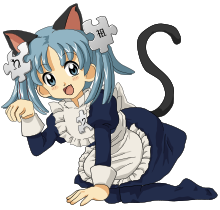


Acatgirl (猫娘, nekomusume) is a young female kemonomimi character with feline traits, such as cat ears (猫耳, nekomimi), a cat tail, or other feline characteristics on an otherwise human body. They are not individuals who are literal cats but individuals who only look superficially feline.[1] Catgirls are found in various fiction genres, particularly in Japanese anime and manga.[2] Catboy is a term for the male equivalent of said character type.
The oldest mention of the term nekomusume comes from an 18th-century misemono (見世物) in which a cat/woman hybrid was displayed.[3] Stories of shape-shifting bakeneko prostitutes were popular during the Edo period.[3] The popularity of the nekomusume continued throughout the Edo and Shōwa periods, with many tales of cat/woman hybrids appearing in works such as the Ehon Sayoshigure (絵本小夜時雨) and Ansei zakki (安政雑記).[3]
InKenji Miyazawa's 1924 work, Suisenzuki no Yokka (水仙月の四日, literally The 4th of Narcissus Month) is the first modern day example of a beautiful, cat-eared woman.[4] In 1936, the nekomusume experienced a revival in kamishibai.[3] The first anime involving catgirls, titled The King’s Tail (Ousama no Shippo), was made in 1949 by Mitsuyo Seo.[citation needed] In America, the DC Comics character Catwoman first appeared in 1940, and Cheetah first appeared in 1943.[5]
Catgirls were further made popular in 1978 manga series The Star of Cottonland, by Yumiko Ōshima.[6] By the 1990s, catgirls were common in Japanese anime and manga.[7] Catgirls have since been featured in various media worldwide. Enough of a subculture has developed for various themed conventions and events to be held around the world, such as Nekocon.[8]
Japanese philosopher Hiroki Azuma has stated that catgirl characteristics such as cat ears and feline speech patterns are examples of moe-elements. Azuma argued that although some otaku sexual expression involves catgirl imagery, few otaku have the sexual awareness to understand how such imagery can be perceived as perverted.[7][9] In a 2010 critique of the manga series Loveless, the feminist writer T. A. Noonan argued that, in Japanese culture, catgirl characteristics have a similar role to that of the Playboy Bunny in western culture, serving as a fetishization of youthful innocence.[10]
The first issue of Batman's self-titled comic written by Bill Finger and drawn by Bob Kane, represented a milestone in more ways than one. With Robin now a partner to the Caped Crusader, villains needed to rise to the challenge, and this issue introduced two future legends: the Joker and Catwoman.
|
| |||||||||||||||||||||||||||||||||||||||||
|---|---|---|---|---|---|---|---|---|---|---|---|---|---|---|---|---|---|---|---|---|---|---|---|---|---|---|---|---|---|---|---|---|---|---|---|---|---|---|---|---|---|
| |||||||||||||||||||||||||||||||||||||||||
| |||||||||||||||||||||||||||||||||||||||||
| |||||||||||||||||||||||||||||||||||||||||
| |||||||||||||||||||||||||||||||||||||||||